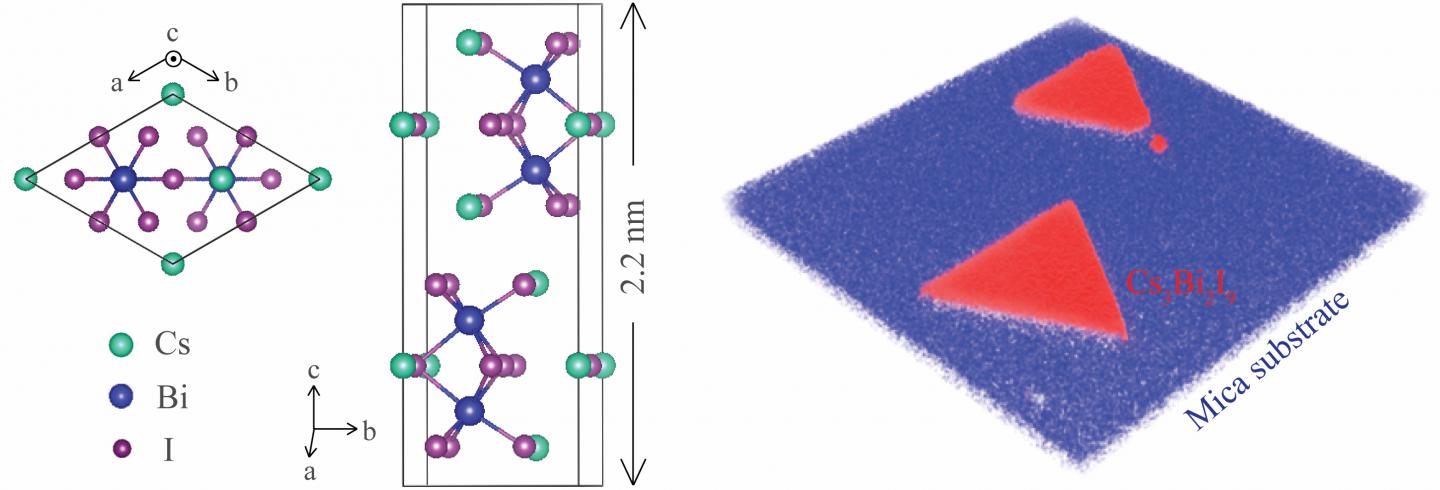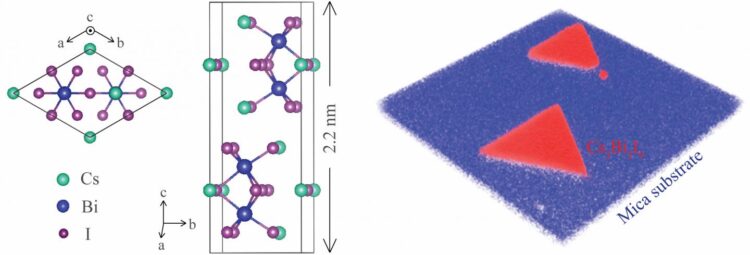Perovskites synthesized at Rice University show potential for valleytronics applications

Credit: Lou Group/Rice University
HOUSTON – (Oct. 26, 2020) – Engineers at Rice University and Texas A&M University have found a 2D material that could make computers faster and more energy-efficient.
Their material is a derivative of perovskite — a crystal with a distinctive structure — that has the surprising ability to enable the valleytronics phenomenon touted as a possible platform for information processing and storage.
The lab of materials scientist Jun Lou of Rice’s Brown School of Engineering synthesized a layered compound of cesium, bismuth and iodine that is adept at storing the valley states of electrons, but only in the structure’s odd layers.
These bits can be set with polarized light, and the even layers appear to protect the odd ones from the kind of field interference that bedevils other perovskites, according to the researchers.
Best of all, the material appears to be scalable.
“This is not a new material, but we figured out a way to make it without solution processing or exfoliating it from bulk,” Lou said. “What’s novel is that we can produce it (via chemical vapor deposition) in a few layers, and all the way down to a monolayer. That enabled us to probe its nonlinear optical properties.”
The discovery is detailed in Advanced Materials.
Valleytronics are a cousin to spintronics, in which memory bits are defined by an electron’s quantum spin state. In valleytronics, electrons have degrees of freedom in the multiple momentum states — or valleys — they occupy. These states can be read as bits.
“In a transistor, if you put an electron there, it represents a state, and if you take it out, that represents another state,” said co-principal investigator Hanyu Zhu of Rice. “In valleytronics, the electrons are always present, and are in either of two different quantum wavefunctions with opposite momenta. These two wavefunctions interact with different light polarization, so the momentum state can be resolved optically.”
A close look at the inorganic, lead-free material through an electron microscope showed molecules in the odd layer are asymmetric. “That lack of symmetry is missing in the even layers — that’s how we differentiate between them — and it gives rise to the properties we see,” Lou said. “That’s just the nature of this crystal structure.”
The lab tested the material with up to 11 layers and found a lack of transparency doesn’t seem to affect how well light triggered a response. “Even a thicker material behaves like it’s still a single layer,” Lou said. “That’s quite important.”
“Thicker 2D transition metal dichalcogenides lose unique properties like valleytronics,” he said. “All the behaviors are gone. That’s not the case for this material.”
Lou said calculations by co-principal investigator Xiaofeng Qian of Texas A&M University provided the necessary theoretical evidence.
“The valley polarization observed in both thin and thick layers is largely due to the weak interlayer electronic coupling, a unique feature of this perovskite derivative compared to other 2D materials when stacked together,” Qian said. “It also leads to persistent nonlinear optical responses in thicker samples.”
The material also seems less susceptible to environmental degradation, a common problem for hybrid perovskites developed for solar energy. “This material won’t give you very high conversion efficiency, but think of it like an all-around athlete in the Olympic Games,” said lead author and Rice postdoctoral fellow Jia Liang. “It may not be the best in each category, but if you consider its different aspects together, it will stand out,” he said.
The researchers suggested the already strong light-matter interaction they observed could be enhanced by further engineering the material’s band gap.
“I think it’s a breakthrough for using this type of material in information processing,” Lou said. “We’re really hoping this is the starting point.”
###
Co-authors of the paper from Rice are graduate students Qiyi Fang, Rui Xu and Kaijun Shen, alumni Shuai Jia and Yuxuan Guan, postdoctoral researcher Qing Ai, research scientist Guanhui Gao, assistant research professor Hua Guo and research specialist Tanguy Terlier; graduate student Hua Wang of Texas A&M; and postdoctoral appointee Xiewen Wen and senior scientist Gary Wiederrecht of Argonne National Laboratory. Qian is an assistant professor of materials science and engineering at Texas A&M. Zhu is an assistant professor of materials science and nanoengineering and of physics and astronomy. Lou is a professor of materials science and nanoengineering.
The Peter M. and Ruth L. Nicholas Postdoctoral Fellowship in Nanotechnology, the Welch Foundation, the National Science Foundation, and the Texas A&M University President’s Excellence Fund X-Grants and T3 Program supported the research.
Read the abstract at https:/
This news release can be found online https:/
Follow Rice News and Media Relations via Twitter @RiceUNews.
Related materials:
Nanomaterials, Nanomechanics and Nanodevices Lab (Lou Group): https:/
Hanyu Zhu: http://zhugroup.
Qian Materials Theory Group: http://people.
Department of Materials Science and NanoEngineering: https:/
George R. Brown School of Engineering: https:/
Images for download:
https:/
At left, top and side views of the crystal structures of perovskite-derived Cs3Bi2I9, a material synthesized at Rice University that shows valleytronics capabilities. Each unit cell contains two neighboring layers with a weak van der Waals interaction in between. At right: an image shows triangles of the material on a mica substrate. (Credit: Lou Group/Rice University)
https:/
The polarized light emission from a 7-layer cesium, bismuth and iodine triangle developed at Rice University, under circularly polarized excitation, shows the valleytronics mechanism in action. The inset shows the electronic state written and read optically in a valleytronic memory. (Credit: Lou Group/Rice University)
Located on a 300-acre forested campus in Houston, Rice University is consistently ranked among the nation’s top 20 universities by U.S. News & World Report. Rice has highly respected schools of Architecture, Business, Continuing Studies, Engineering, Humanities, Music, Natural Sciences and Social Sciences and is home to the Baker Institute for Public Policy. With 3,978 undergraduates and 3,192 graduate students, Rice’s undergraduate student-to-faculty ratio is just under 6-to-1. Its residential college system builds close-knit communities and lifelong friendships, just one reason why Rice is ranked No. 1 for lots of race/class interaction and No. 1 for quality of life by the Princeton Review. Rice is also rated as a best value among private universities by Kiplinger’s Personal Finance.
Media Contact
Jeff Falk
[email protected]
Original Source
https:/
Related Journal Article
http://dx.





